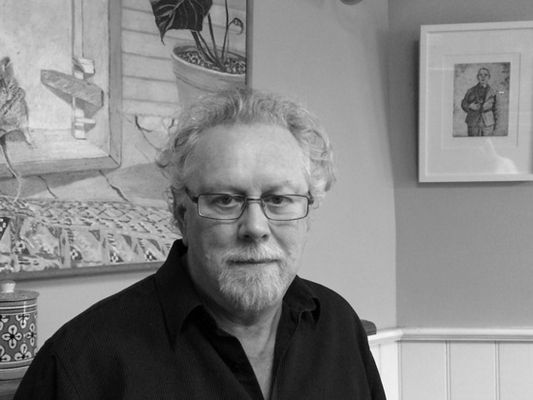John A. Scott’s long-awaited novel, N, is set in a re-imagined, though frighteningly familiar, Australia. Moving between the stories of artists, soldiers, public servants and visionaries, and told in a breadth of narrative styles, N is both a love story and political thriller. Here, Scott talks with David Brooks about writing this work of epic scope and masterful intricacies.
It is wartime – 1942 – and Australia is occupied by the Japanese. Sydney has been devastated. Melbourne is the centre of a Vichy-like puppet government (which soon decamps to Mount Macedon), and a strange ghost-war is being conducted in the countryside. There are pockets of resistance and refuge, one of them ruled over, it would seem, by Gertrude Stein and Alice B. Toklas. And for anyone living in contemporary Australia some of the undertexts are hauntingly familiar.
The brief title of John A. Scott’s masterful new novel is notable, though there have, of course, been other books with single-letter titles – Thomas Pynchon’s V, Georges Perec’s Oulipian W, and Peter Robb’s M: The Man Who Became Caravaggio – and Scott’s work is perhaps nodding to some of them. Painting is important to it (Tucker, Nolan and others are here, and several of N’s central characters are painters); its narratological acrobatics and intertextual intensities would attract any Oulipian’s attention, and Pynchon’s mysterious protean comes often to mind as one reads through Scott’s marvellous labyrinth. There’s also Fritz Lang’s cinematic classic M (1931), though in place of the famous scene in which the ball rolls away from the murdered girl there’s a potato straight from Joyce’s Ulysses.
N is like that. One of its characterising features, Scott says, ‘is the way it utilises a wide variety of intertwining modes: from documentary, journalism and social realism, to poetic fiction, to magic realism, fantasy and the surreal … One of the early models for the book was television news where comic and tragic events are presented one after the other.’
Daunting, one might think, but Scott wears his textual erudition lightly, and the reader is too engrossed to mind. N’s realism is magical, and its magic remarkably real. ‘One of the many miracles of this wonderful book,’ Martin Duwell has written, ‘is the fact that within the pyrotechnics of its multiple styles and alternative histories are contained the lives of human beings whose fates we grow to care desperately about.’ At its heart are two love stories – of Telford, a senior public servant, and Esther Cole, a woman determined to discover the truth of her politician husband’s death, and of Missy Cunningham and the artist–soldier Vic Turner – and the work overall is shot through with a serious moral and political intent, as if through all its ludic adventures it never loses sight of the questions with which it wants to interrogate us. It begins with the Nancy, a ship full of child-refugees from war-torn Europe, and a decision by Arthur Fadden’s war cabinet to send them packing. It ends with SIEV 4 and the ‘children overboard’ scandal.
‘Realise,’ wrote Leonardo da Vinci, ‘that everything connects’ – or Dig, as the ubiquitous, imperative title of Frank Clune’s account of the Burke and Wills expedition tells so many of Scott’s characters to do. N could almost be written in demonstration. Underneath its surface, for example, spreads a large network of tunnels that characters enter from various parts of the narrative, sometimes finding themselves, as they cross a branch line, hearing dialogue from other parts of the novel. There’s the bunyip from one of Ola Cohn’s books, which has escaped from the page and eventually carries off a soldier in a remote NSW country town hundreds of pages away. There’s a long set of underground chambers beneath Mount Macedon which Telford must explore to find the truth that Esther seeks. There’s also the journal Southerly, which has just published (in Vol.73 No.3) a self-contained novella by Scott about the adventures of André Breton in Melbourne in 1942, and once a storyline in N.
‘In an earlier draft,’ Scott explained in our interview, ‘the Breton narrative occupied the role of “surrealist writing” in the range of modes I mentioned. Breton proved to be a popular character for early readers, but much of his story happens in the early part of the book, which slowed the opening – not a good thing in a book of N’s length. There is probably another book’s worth of material – Missy’s backstory, a series of short pieces on aspects of the bombing of Darwin; alternative versions of the Battle of the Coral Sea and Guadalcanal; and a large number of chapters concerning minor characters and situations. I would like to see these “unused narratives” published in a range of magazines – like a set of outposts joined to a city by hidden tunnels.’

An alternative title of N at one point was Inland Sea, that holy grail of Australia’s early explorers. Robert O’Hara Burke – yet another of Scott’s real-yet-fictional characters – is so convinced that he will find it that he drags with him a crude amphibious cart named the Nancy (yes, you’re getting it …), which, in one of Scott’s most remarkable scenes, a party of Australian soldiers and their Japanese captors encounter, deep in the desert, on a vast body of improbable water.
Many of Scott’s narratives lead to this place. It is one of the triumphs of this remarkable work that this inland sea becomes not only a haunting revisioning of our own mythology and comment upon our contemporary predicament, but also – as a kind of Book of Books, a Story of Stories – a holy grail of narrative itself.


